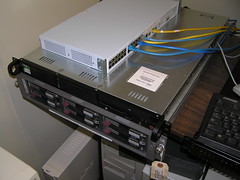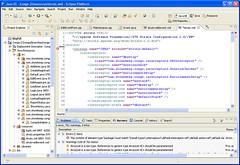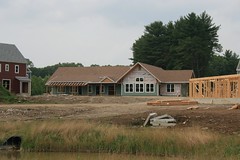I’m looking for something, maybe folks can help me out.
I want a small MP3 player that will stream audio over the network. The commercial version is the Roku Soundbridge. I wouldn’t mind building my own, hacking together parts, whatever, but I really haven’t found something that fits the bill.
Here’s the requirements:
* Must stream MP3 from a remote (network) source
* Can be wireless or fixed wire
* Should be small enough to mount on a wall
* Laptop running Linux is POSSIBLE, but only something that could mount / sit in Tablet orientation
* Total cost should be less than $50
* Should have at least a minimal display showing volume, source, and current track
* Line level output (RCA or headphone jack)
* Prefer opensource / linux based, but a commercial solution would work also.
* Should have local controls for pause, next track, volume, but not a requirement
The best configuration I can come up with is a handheld device running Angstrom or the like, but the most baseline iPaq or similar is still $50-$60, and I dont’ have a lot of experience with the current generation of iPaqs.
I’ve also considered picking up a Zaurus SL-5500 or two and using them. They seem to go for a good price on eBay, and certainly are opensource. Good video, touchscreen, and can take an SD card for network.
Anyone else have any ideas? There are zillions of opensource MP3 player boards on the web, but none have network interfaces on them (that I could find). I’m open to suggestions!
Month: July 2008
It’s Sysadmin Appreciation Day!
 Hey kids, it’s Sysadmin Appreciation Day! Go out and give your admin a hug, a smooch, and buy ’em lunch!
Hey kids, it’s Sysadmin Appreciation Day! Go out and give your admin a hug, a smooch, and buy ’em lunch!
I have mad appreciation to all my co-administrators working on the Greater Homeport Server Cluster. We have a lot of users, a lot of sites, and do a lot of good stuff. Because of the purely volunteer hard work done by these people, we have happy users, stable hosting, and very very few outages.
Super-duper mad props to…
Dwight Ernest – owner of ‘msb’ and ‘msb2’ – he helps keep our network glowing.
Mort – he of the ever-patient Movable Type hackery and general “No problem, I’ll take care of that” approach to stuff.
Tim Pierce – a former demigod of Usenet, now good friend and one of the first in the line of fire when Stuff Breaks. I, sir, salute you.
The Greater Homeport Servers can’t function without help from all the community members. I want to also send thanks to others who have done a ton of help with technical and content related stuff…
Lisa Holsberg – while not technically a sysadmin, Lisa is our primary Movable Type geek, and we wouldn’t be able to run our blogs without her help.
Catya Belfer-Shevett – When I first set up Drupal for Arisia, Cat jumped in and is now a Mad Drupal Goddess.
Luwenth – Luw owns the machine(s) that function as Homeport’s secondary DNS servers out in California, and has jumped in and helped several times when we’ve had Issues. Thank you!
Nathan Mehl – I’ve known Nathan for many years, and have an enormous amount of respect for him. Right now, Nathan runs a machine that helps keep our IRC network stable. Thank you!
Picker / Selector for GSM phones?
So I’m getting ready to make the jump away from Verizon, and it looks like we’re going to be going with a GSM-based provider. I’d like to see a picker / selector for GSM phones that lets me pick phones based on criteria.
Anyone know of such a beast?
My baseline criteria is:
- Does not run a Microsoft OS
- Is not an iPhone
- Is not a PalmOS Treo.
- Has a full Bluetooth stack – including A2DP, various HID profiles, etc
- I’d prefer a full keyboard, but I can wiggle on that
- Music support, with open formats (I can put my own MP3’s on it)
- Very good Bluetooth ‘modem’ capability. Want to use it as a data gateway for my laptop
- At least a few games. The only game I really play on my Treo anymore is Sudoku. I think that may be a dead requirement on any replacement device.
My current top contender is the Nokia N95-3 (the North American version). Pricing is down to about $300 (the -3 is a slightly ‘older’ version, but has a removable Micro-SD slot – pretty good for loading music and other stuff on it), but I want to make sure I’m not missing out on something. (Oddly, I can’t find that price on Amazon now. I’ll keep looking).
One possibility is going with a fairly cheap, capable Bluetooth enabled handset now – no music, games, etc, but able to function as a phone and a GSM modem, and look toward an Android based solution in the next 6 months.
Pointers?
Back in the Real World
I’m on my way back from camping this weekend. Sitting here in the Pittsburgh airport, it’s sort of odd having the trappings of modern society all around me again, having spent the last 4 days and three nights sleeping in a tent (on the ground, no air mattress), and hiking through knee-high grass several times a day to socialize and get food.
There’s much to talk about, all sorts of geeky interesting things to go on about camping, food, waste, economy of living, and social interactions, but for now I’m just going to enjoy the air conditioning and modern plumbing.
Eclipse XML Validation can BITE ME
There are times when I want to take an axe to Eclipse. Today’s particular grief is due to the XML editor. There are numerous faults with it (one of the biggest is that it ‘captures’ the control-pgup and control-pgdn keys into local tabs, so if you have an XML file open, and you use the keystrokes to navigate through your files, when you switch tabs to an XML file, the only way you can view a different file is to click on it), but todays stabbity-stab comes from the validator.
 Eclipse shows you errors and warnings in realtime. Usually, they’re fairly accurate. Today I was editing a struts.xml file, and was getting a validation warning. When Eclipse senses a problem with the XML (based on it’s DTD), it tells you “this XML file fails the DTD validation”.
Eclipse shows you errors and warnings in realtime. Usually, they’re fairly accurate. Today I was editing a struts.xml file, and was getting a validation warning. When Eclipse senses a problem with the XML (based on it’s DTD), it tells you “this XML file fails the DTD validation”.
But it doesn’t tell you where.
This completely baffles me. “Somewhere in the following several hundred lines of XML code, there’s a problem. But I won’t tell you where or what it is.”
Off to the W3.org Validation service. I fed the XML file into it, and lo! A detailed description of the problem, and where it was:
Line 26, Column 39:
document type does not allow element "include" here.<include file="struts-editevent.xml"/>
Was that really that difficult?
Gnar.
Gotta Love Americans
Or maybe it’s just New Englanders.
Shall we run down the list here?
1) Big ass SUV.
2) Parked as annoyingly as possible (I suppose they could have gone diagonal and covered 3 spots)
3) Bike rack that sticks a good 3.5 feet out into the lot (empty)
Understanding that at one point I actually owned a Suburban just like this, I think I can safely say I at least had some clue how to park it.
Giving Back – Working for OLPC
It’s no secret I’ve been a huge fan of the One Laptop per Child project. After all, I contributed to the Give One Get One project, and obtained a unit for my son Zach, which meant a child elsewhere in the world received a laptop as well.
Following this success, and watching Zach teach himself Python and learn basic programming skills using Scratch, I found myself wanting to do more to support OLPC. I don’t have bottomless resources to throw at the project, but I still wanted to contribute somehow.
After getting to know some of the project folks, and after some back and forth, I was admitted to the OLPC Support crew, and now am an official OLPC Support Volunteer.
What this means is when I have some spare time, I log into the support system and answer questions from folks all over the world about OLPC, the laptops, and the applications. I’m a volunteer, so I’m not paid, but I feel that I’m giving something to the community. I can answer questions and communicate clearly, there are people who need help. For the most part, these are people who, like me, feel the OLPC project is important, and are willing to contribute to it, and get a unit of their own to boot. I’m proud to help them out as much as I can.
In 4 days, I’ve handled about 38 problems. That’s 38 people who are a little better off with their machines than they were before.
This is one of the few true volunteer organizations I’ve ever committed myself to. I’ve always given financially to causes I believe in, but when it comes to manning booths or spending weekends “lending a hand”, it’s usually been isolated to things like SF and gaming conventions.
This is bigger. This is important. This means something.
And I’m helping it be successful.
It feels good.
Cohousing Affordable Housing Open to Qualified Buyers
I’m signal boosting this message a bit. Our cohousing group (collectively Sawyer Hill Ecovillage, consisting of my group, Mosaic Commons and a second community, Camelot Cohousing) have just completed the state-mandated lottery for offering our affordable units to qualified buyers under the 40b Affordable Housing law. Because we did not have a full slate of applicants, the process is now thrown open to anyone who qualifies within the 40b limits.
If you’ve been interested in our project, and have held off because of the daunting numbers, now may be a perfect time to look into it. These units are being offered on a first come, first served basis.
We have 40b units available priced between $136k and $176k
The 40b limitations are:
- Income limits between $46k/year and $76k/year, depending on number of family members.
- Assets no more than $75k
Note there are a variety of exceptions for seniors, single parents, etc. See this web page for details.
We also still have a few market rate units for those families
who don’t meet the limits for the affordable units, so come
check us out: http://www.sawyerhill.org.
Maine Fireworks!
This past weekend I was up with the Fam in Maine doing our traditional July 4th joy. A lot of fun to be had – the weather cooperated (not too hot, not too cold), we got some good time on boats and ate gobs of food.
Thursday night we went to Sanford, ME, as we usually do, and saw the fireworks show there, alongside probably 5000 other people all camped around a lake. As always, it was a great show.
This time I decided to try and photograph it. For the camera geeks, I used my 50mm lens, F-stop all the way open to 1.8. ISO was wobbling around, but I settled down to a very low 200. I was worried it wouldn’t be fast enough, but with a 1/15th second shutter speed, it worked out fine.
The gaping F-stop meant my depth of field was measured in feet, even 300ft away from my subject (the fireworks themselves). I could not autofocus for obvious reasons, so with a lot of experimentation, I found “All the way out, backed off about 10th of a turn” seemed to be the ‘sweet spot’ for focus.
As usual for these sorts of shoots, I shot a LOT. 320+ images for 1/2 hr show (filled my 1gig memory card). From that, I ended up with less than 50 useable images.
I may take a handful and postprocess further into a nice gallery, but this was a good first attempt. The one thing I didn’t expect was the reflection you can see in some of the brighter images. What I’m guessing it is is the image reflected onto the UV filter off my primary lens. I should have thought to remove that filter for such bright shots, but that’s the joy of experimenting, eh?
Anyway, enjoy!
Jumping the RSS train Again
About 3.5 years ago I changed my web surfing habits and went totally into “RSS Aggregator” mode. Initially I was using the Sage RSS reader, a Firefox plugin. It worked well, and with Google Browser Sync I was able to sync my views. Or so I thought.
The syncing of my feeds never actually worked too well, so if I finished reading articles on one machine, when I sat down at the other, I couldn’t be sure if the ’18 new articles’ really meant 18 new articles. Also, Google Browser Sync is being end of lifed, so I need to find an alternative.
For a while, I switched to using Akregrator for KDE. All in all, I found it a fantastic tool, very fast, easy to use, and well integrated into KDE. Alas, I don’t always sit at my desktop machine, and really started pining for a way to stay synced on my feeds while out and about, while still being able to read at home.
After denying the inevitable for so long, I’m now working with Google Reader, which appears to do everything I need in an RSS aggregator, and is not localized to one specific machine. I’m slowly migrating my vast array of feeds (somewhere around 200) into it, and organizing them into folders by subject.
So far, I’m reasonably happy with it. It works, it’s fast, it’s ubiquitous, and, well, it’s Google. I have some real issues with how Google is overly dependent on their AJAX magic to get things done, though Reader doesn’t seem to too overboard with it (unlike, say, something like Picasaweb, which I loathe).
I’ll give it a few weeks and see how well I like it. Fortunately, it hasn’t required a major investment in time or configuration to set up. About an hour of basic twiddling and I’m up and running. Stay tuned!


